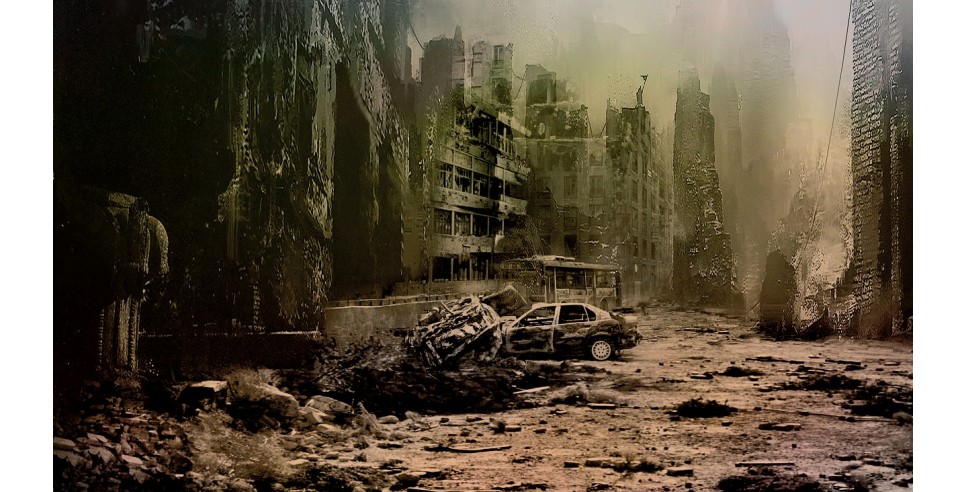
When the biophysicist Jeff Gore and a team of scientists at MIT placed a colony of soil bacteria in a container along with an abundance of glucose and other nutrients, the colony grew exponentially at first but then went into a death spiral and crashed. The bacteria were poisoned by their own ever-increasing wastes and were helpless to avoid the lethal consequences. Very suggestive, needless to say!
Something quite different but equally catastrophic occurred when the U.S. Coast Guard introduced 29 reindeer onto St. Matthew Island in the Bering Sea in 1944, where the vegetation was then abundant. However, there were also no major predators on the island. (Diamond, 2005). So, in the absence of any constraint, the herd grew to 6,000 animals by 1963, and, in the process, decimated their food supply. The end result was starvation and a population crash. By 1966, only 42 reindeer were left, and by 1980 they were all gone. Once again, it was very suggestive.
Or consider this iconic human example. The remote Easter Island in the south Pacific, long famous for its hundreds of massive stone statues, has also become a metaphor for a self-inflicted ecological disaster. Starting with a handful of Polynesian settlers in about 900 A.D., the Easter Island population expanded over time to an estimated 20-30,000 people on an island that is only 9 miles wide (about 44 square miles). As their numbers grew, the islanders denuded the island’s once thick forest, depleted its topsoil, wiped out its resident species of large birds, totally consumed a wood supply that was needed to build canoes for offshore fishing, and devolved into a dozen warring clans that suffered widespread starvation and even cannibalism. After the island’s population had declined by an estimated 70%, a smallpox epidemic, unwittingly introduced by European traders, provided the coup de grace, along with the kidnapping of the island’s remaining young men to become slave laborers.
The full story of Easter Island is complicated. Among other things, it involved a unique natural environment that was easily damaged and was unusually challenging for agriculture. However, the combination of wasteful and destructive social practices and uncontrolled population growth also played a major role. Jared Diamond, in his landmark book, Collapse: How Societies Choose to Fail or Succeed (2005), concluded that “Easter’s isolation makes it the clearest example of a [human] society that destroyed itself by overexploiting its own resources…. The parallels between Easter Island and the whole world are chillingly obvious.”
The ecologists call it “eco-suicide,” and it is far easier to do and more predictable than we had once thought. Indeed, our entire history as a species provides a cautionary tale. The archeological record is littered with examples of ancient human societies that have vanished – many of them as victims of ecological disasters – from the very first city, Ur, to the Sumerians, Babylonians, Akkadians, Old Kingdom Egypt, the Hittites, Minoans, Mayans, Incas, Aztecs, Olmecs, Teotihuacan, the Anasazi, the Carthaginians, the Khmer Empire, and others.
Jared Diamond, drawing on the case-studies in his definitive study, developed a five-point framework of causal factors that singly, or in combination, can lead to a societal collapse. These factors are (1) environmental damage, (2) climate change, (3) the actions of hostile neighbors, (4) the loss (or lack) of friendly trading partners, and most important, (5) how a society responds to its environmental constraints and emerging problems. Cultural values, social institutions, and the actions of leaders can make a huge difference in the outcome. For instance, Diamond pointed to examples of societies such as Japan and the New Guinea Highlands that were able to avoid the fate of Easter Island by developing successful forest management practices. (Stick a pin in this point.)
All of us today are living in a world where population growth and resource consumption have outstripped what the ecologists call our “carrying capacity.” Our wastes, especially CO2, have become a major threat. Non-renewable resources are being rapidly depleted. Food shortages are becoming ever more severe, and many nations are already scrambling for scarce food and water. There is, in fact, an emerging global competition for food and water resources that carries with it the potential for evoking mass violence. (See also Nolan, et al., 2018.)
Another flashpoint may be the various land (and water) acquisitions across national borders, either through outright purchases or long-term leases. These have multiplied in recent years. China, India, Egypt, South Korea, and Saudi Arabia are among the leaders in pursuing this acquisition strategy. It is ominous that many of these foreign acquisitions are being made through corrupt officials in poor countries that are struggling to feed their own people. Even the United States has become a target; foreign investors now own some 30 million acres of prime American farmland.
A third potential flashpoint for political conflict is the growing number of cases where governments have overruled the private sector and restricted the export of food products during a bad growing season. It seems that national self-interest can trump contractual obligations. The U.S. did it during the 1970s; Russia and Argentina did it with wheat in 2007; Vietnam did it that same year with rice; and Russia did it again during the great heat wave of 2010. Scarcity, by its very nature, converts cooperation into a zero-sum game – a game of winners and losers with, quite possibly, life and death consequences. Malthus meets game theory.
The philosopher George Santayana long ago warned us that “those who cannot remember the past are condemned to relive it,” while Mark Twain is reputed to have said that history doesn’t exactly repeat itself, but it does tend to rhyme. Indeed, it may even plagiarize itself. If we ignore the lessons of history, or else delude ourselves by thinking that the past is not relevant, our species will pay a terrible price.
To put it very simply, food and water scarcity breeds desperation, and desperation breeds resistance and revolt, and revolts are typically bloody and often end badly for everyone concerned. Bread – or the lack of it – was the underlying cause of the French Revolution in the 18th century, and of the Russian and Chinese Revolutions in the twentieth century. In each case, the ruling classes resisted making changes and ultimately went to the guillotine, or to Siberian Gulags, or Chinese labor camps. Or to the death camps. Hitler came to power in the 1930s in a German nation that had been impoverished by punitive war reparations after its defeat in World War One and then was struck with runaway inflation and a deep economic recession.
Likewise, in the twenty-first century the Arab Spring, the rise of ISIS terrorism, and the tragic civil war in Syria were almost certainly all triggered by a huge spike in grain prices and spreading hunger as a result of droughts in Syria, Russia, and elsewhere in the Middle East, combined with the diversion of a major share of America’s corn crop into making ethanol fuel for automobiles and financial speculation in global commodity markets. The civil war in Yemen was presaged by severe water shortages and repeated dire warnings that were never heeded. And the “caravans” of refugees coming from Central America to the southern border of the U.S. in the past few years were motivated by climate change and the dire consequences for agriculture in that region.
Thus, one of the great lessons of history (and pre-history) is that societies and their leaders (and their elites) often have fateful, life-and-death political choices to make, and these can play a decisive role in how a society responds to its challenges – as Jared Diamond highlighted (see also Flannery & Marcus, 2012).
Consider the French Revolution. As in most other great political upheavals, there were a variety of factors that contributed. However, the common denominator – as in every other major revolution – was extreme poverty and hunger coupled with corruption and obscene wealth for the few, and a failure of the regime to provide relief. In the modern-day Syrian cataclysm, likewise, the oligarchs of the Assad regime responded to the hungry protesters who were out in the streets engaged in peaceful demonstrations by shooting and killing them. This obviously didn’t solve the problem. The recent rioting in Iraq and the economic disaster in Venezuela also come to mind.
The typical result of these traumatic political upheavals is a cure that may be just as bad as the disease for the aggrieved population – like the Reign of Terror and the so-called “Thermidorian Reaction” in France, the brutal tyranny and widespread suffering under Joseph Stalin in Russia and Mao Zedong in China, the genocide perpetrated by Pol Pot in Cambodia, and the many millions of casualties and refugees in Syria, along with the wholesale physical destruction of that country. In most of these revolutions, the ruling elite also pay the ultimate price. Call it the revenge of the masses.
Just as the French Revolution was inspired in part by the model of the American Revolution, the British were affected in different ways by the revolution in France, and it precipitated a wave of political agitation and pamphleteering. Some observers were enthusiastic supporters, at first. Perhaps most famous was the prominent minister Richard Price, whose 1789 essay “Discourse on the Love of Our Country” invoked the supremacy of freedom and inherent human rights, the right of the people to choose their leaders and oppose abuses of power, and the role of reason as a guide to political action. Price was seconded by, among others, the British/American revolutionary Thomas Paine in his essay on “The Rights of Man,” (1791-1792) and by Mary Wollstonecraft, also an early advocate for women’s rights. However, as the revolution turned anarchic and bloody, some of the early supporters lost their enthusiasm.










